Not to bore you with statistics, but these are mind boggling and worth noting: Each person in Truth or Consequences (T or C) generates about 150 pounds of trash per month. Based on a population of about 6,000, that comes to a staggering 900,000 pounds every 30 days. Let’s see…it means we produce 10,800,000 pounds a year, and that’s only from locals. Add the litter generated by visitors who come to soak or recreate at the state park, for example, and that number almost doubles, a lot of which ends up along our highways.
New Mexico, especially our area, is beautiful. We have mountains, the largest lake in the state, scenery galore, and sparkling deserts, yes literally sparkling from the tons and tons of broken glass that cover the desert floor. When driving around Sierra County I can’t help but recall the TV ad from years back that showed a Native American shedding a tear over the litter surrounding him. I can’t imagine what visitors must think when they get off the interstate and head to Elephant Butte, where its looks like trash was intentionally dumped along the full 5-mile route. It leaves an awful first impression, not to mention creates an eyesore for us who see it every day.
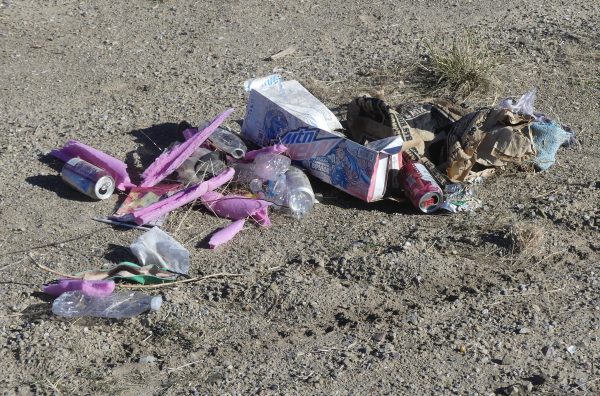
Granted, some of the trash along the highway is blown there, from the landfill or from anyplace it’s not anchored down against New Mexico’s notorious winds. While volunteering at the state park, I was introduced to litter picking, and enjoyed it so much that I rarely left home without my grabber. I always was, and still am, amazed at what I’d find along the road, in the mesquite, and even packrat nests. After several years of picking litter along Lake Shore Road I’ve noticed a pattern: the majority of the trash consists of beer cans and beer bottles (I doubt very much that the bottles blew there), plastic water bottles, plastic shopping bags, miscellaneous broken parts from boats and campers, and the ever present ice bag that blew out of the back of a boat. Closer to town fast-food bags, paper and Styrofoam cups, and even household garbage are more common.
Good news/bad news: Plastics and Styrofoam do degrade and actually disintegrate to almost a powder if you try to pick them up. Disintegration is good, yes? Not necessarily—these particles are so fine they run off with rainwater or soak into the sandy soil, either way winding up in the lake and rivers and eventually us. Ironically, those people who come to fish the lake and who accidentally or intentionally litter are the same ones ingesting that trash. Again with the statistics: It’s alarming to know that each person eats the equivalent of a credit-card’s worth of plastic each week, creating all kinds of havoc with our bodies and especially the GI tract, but that’s another article entirely. Needless to say, plastic should not be on our menus.
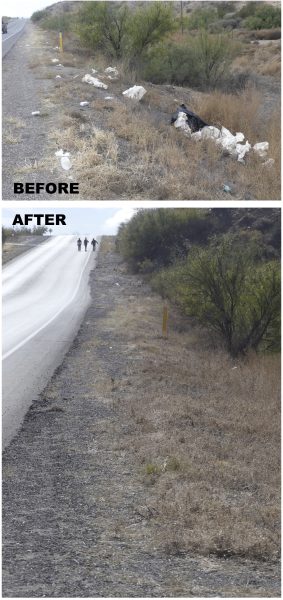
However, litter isn’t limited to the roads—Elephant Butte Lake’s beach has more than its share. Findings left behind by dropping water levels include a full set of bedsheets still in their package, a nearly full case of beer, and towels: dish towels, bath towels, washcloths, tea towels. I’m still using the small Swiss Army knife I found as well as a vase that now holds an aloe plant, also tossed along the beach. I’ve removed tires, lawn chairs, and tents and more nuts and bolts than some hardware stores stock. In fact, the only thing missing from my list is the kitchen sink, but give it time—it will show up. Cigarette butts are everywhere. To break the monotony of a slow pick day, I decided to count butts, which totaled a full pack‘s worth in roughly a quarter mile—it adds up. Unfortunately it’s impossible to pick up all the tiny bits of broken bottles, but I do pick intact bottles and large chunks.
There is the occasional exception to littering, when it’s impossible to stop a piece of paper from flying out your window, much less go back to pick it up, but these instances are few, very few. More than once I’ve had people stop or give a friendly toot to thank me for my service; however, I’ve also had one person throw litter out the window as they passed me. Guess they figured I’d pick it up. I did.
Fortunately I’m not alone in noticing all our roadside junk: Since 2021 a group in T or C—aptly called the T or C Litter Pickers—was formed. Their organizer, Cathy Mears-Martin (executive director of T or C’s MainStreet organization), notes that the group is about 300 members strong, but “members” might be a misnomer: there are no dues, no sign-up or registration, no meetings. All events are posted on social media, and announcements made as to the next gathering, which includes T or C as well as Elephant Butte. Cathy notes that members come out as they want to, where they want to—some to their favorite picking grounds. The group frequently picks Rotary Park as well as town, but also goes to the lake. During World Cleanup Day in September, picking was gamified by initiating a start and end point and offering prizes for the oddest thing found (an electric razor part) or the most litter picked, for example. At Rotary Park the more common items are “fishing gear—line, hooks, and lures; at the beach it’s mostly bottle caps, plastic bottles, and a sock—we always find a sock, one sock,” she says.
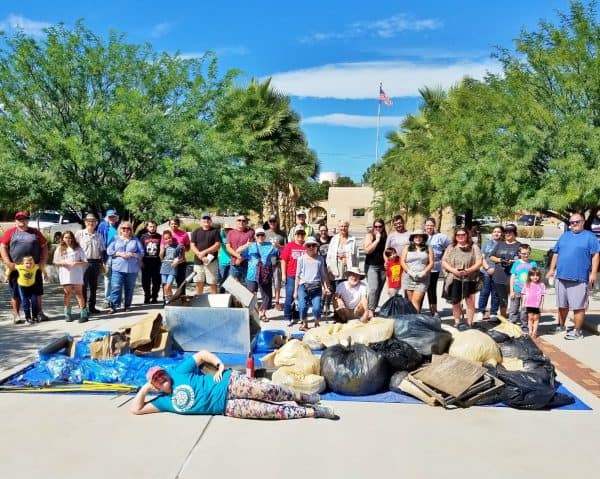
Like most anything there are do’s and don’ts to litter picking. First, use common sense and wear sunscreen and a hat, carry water, and wear good sturdy shoes—mesquite thorns can puncture your soles—trust me. If it’s not too warm, long-sleeved shirts will help protect you against reaching in among the thorny mesquite. A reflective vest, gloves, and a grabber are essential, and always watch for snakes.
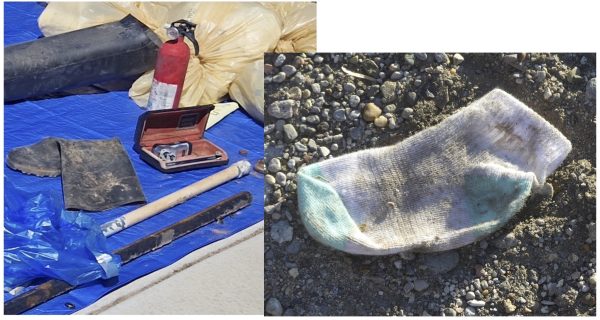
It’s best to go with someone rather than solo but if you stick to a well-traveled road, going alone isn’t a problem. There’s only one condition under which I won’t pick—wind. A light breeze maybe but anything more will frustrate you. I usually carry a bucket, pick an area to fill it, then dump it into a larger bag after pulling out aluminum cans for recycling. My rule used to be to pick as far off the road as I could see but aging joints have shortened that to 10 to 15 feet from road’s edge. I hate to leave anything that’s visible, but there is a limit.
Although you might not want to add Litter Picker to your resume, it’s a great pastime. Not only do you benefit from sunshine and vitamin D, exercise, and camaraderie with other pickers, it’s almost a Zen-like experience—you can be alone with your thoughts, enjoy the quiet, and know you’re doing something good for the planet.
Depending on your definition of the term it can even be fun—think of it as a scavenger hunt. Is it a never-ending job? You bet, so get a grabber, bucket, and bag and head out. Just an hour will yield noticeable results. And you never know what you’ll find.
Photos provided by the author and Cathy Mears-Martin
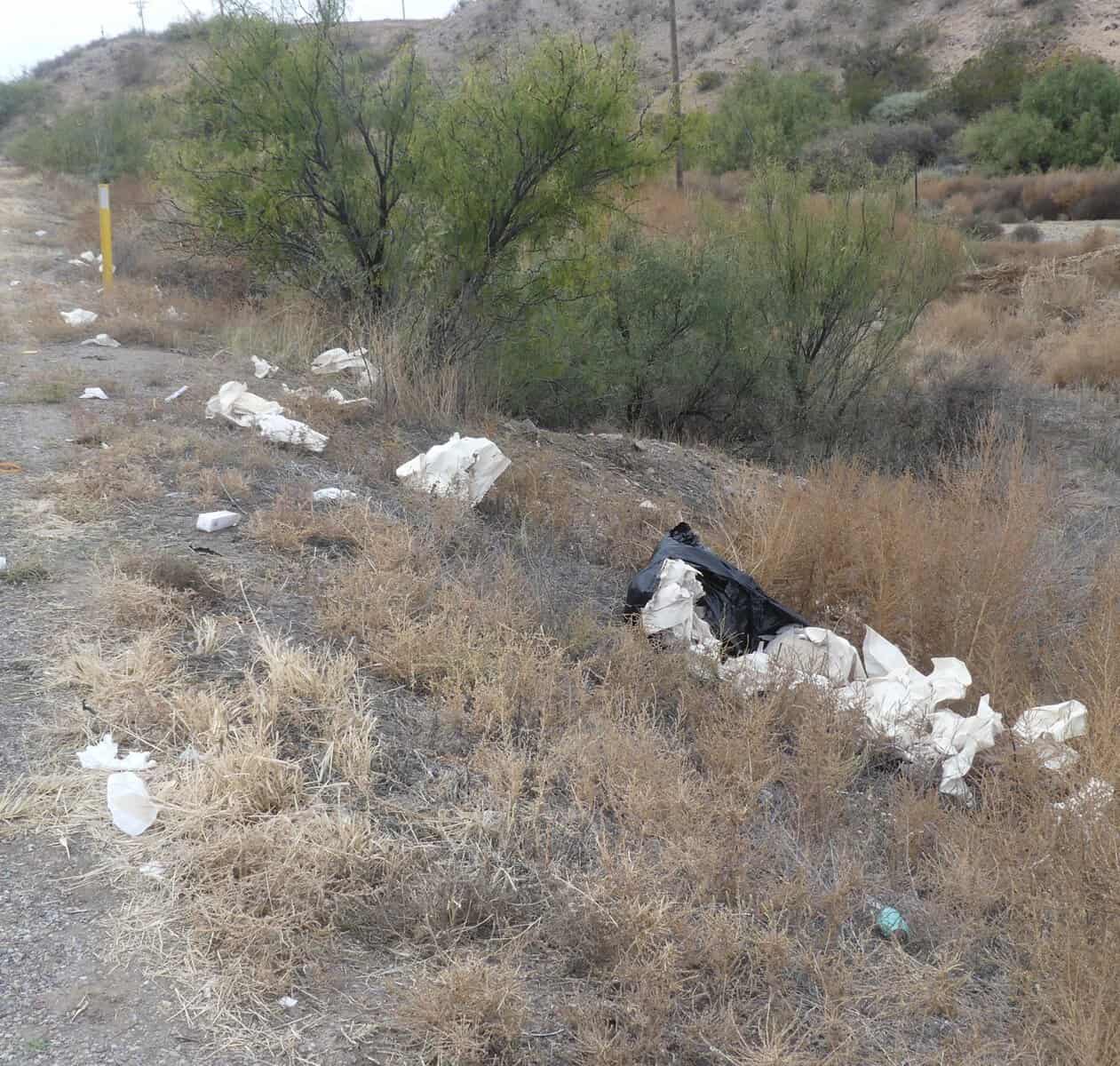

Fabulous work these litter-pickers do. Thank you. I just want to add that it’s not just local and visiting individuals that create the litter. The state highway department also contributes a lot of litter after highway resurfacing when they place those plastic tabs on the roads where the center and side lane marks are to be painted. Once after a short hike of litter-picking on Highway 27 south of Hillsboro, I separated the DOT litter from all the rest. About half the content of that bag was courtesy of the DOT.
Perhaps locals are littering as an indirect response to local government. Maybe it’s hard to have pride and act responsibly in a town where the leadership dumps all over the place ethically.